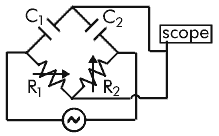1)
Using your measured values for A and B, analytically determine the
effective capacitance of A and B when they are placed in series.
2) Connect A and B in series. Repeat part I, steps 1-5, but
instead of attaching capacitor A, attach the "A series B" capacitor.
This is the experimentally determined the
effective capacitance of A in series with B.
3) Repeat for A and B in parallel.
Part III: Homemade Capacitor
The homemade capacitor is a capacitor made out of two sheets
of aluminum foil with a transparency between them. The capacitance
of our homemade device is very small (~10 nF). To determine the
capacitance, we will have to make our capacitance meter more sensitive.
1) Pick the smallest capacitor from part I and connect them in series
to the orginal C1. These two capacitors are now the new C
1. Camke sure your oscilloscope is attached to the end of the new C
1, not the old one.
2) Using your modified capacitance meter, find the capacitance of the homemade
capacitor.
1. What is the value of k for our homemade capacitor? (Show your
work)
2. If I add a capacitor (C1) in series to another (C2), will
I increase or decrease the capacitance of the overall circuit? Justify
your answer.
3. If I add a capacitor in parallel to another, will I increase
or decrease the capacitance of the overall circuit? Justify your
answer.
0 is the permittivity of free space = 8.85 x 10 -12 F / m, and k is the dielectric constant. If there is no material between the plates of a capacitor (a vacuum) then k is 1. You will learn about dielectrics in your lecture class; in the lab all you need to know is that a dielectric increases the capacitance of a capacitor (i.e. k > 1).

